The degree-restricted random process is far from uniform
IF 1.2
1区 数学
Q1 MATHEMATICS
引用次数: 0
Abstract
The degree-restricted random process is a natural algorithmic model for generating graphs with degree sequence : starting with an empty n-vertex graph, it sequentially adds new random edges so that the degree of each vertex remains at most . Wormald conjectured in 1999 that, for d-regular degree sequences , the final graph of this process is similar to a uniform random d-regular graph.
In this paper we show that, for degree sequences that are not nearly regular, the final graph of the degree-restricted random process differs substantially from a uniform random graph with degree sequence . The combinatorial proof technique is our main conceptual contribution: we adapt the switching method to the degree-restricted process, demonstrating that this enumeration technique can also be used to analyze stochastic processes (rather than just uniform random models, as before).
受程度限制的随机过程远非一致
度限制随机过程是生成度序列dn=(d1,…,dn)图的一种自然算法模型:从一个空的n顶点图开始,顺序地添加新的随机边,使每个顶点vi的度最多保持di。Wormald在1999年推测,对于d正则次序列dn,该过程的最终图类似于一致随机d正则图。在本文中,我们证明了对于不接近正则的次序列dn,限制次随机过程的最终图与具有次序列dn的一致随机图有很大的不同。组合证明技术是我们的主要概念贡献:我们将切换方法适应于程度限制过程,证明这种枚举技术也可以用于分析随机过程(而不仅仅是均匀随机模型,就像以前一样)。
本文章由计算机程序翻译,如有差异,请以英文原文为准。
求助全文
约1分钟内获得全文
求助全文
来源期刊
CiteScore
2.70
自引率
14.30%
发文量
99
审稿时长
6-12 weeks
期刊介绍:
The Journal of Combinatorial Theory publishes original mathematical research dealing with theoretical and physical aspects of the study of finite and discrete structures in all branches of science. Series B is concerned primarily with graph theory and matroid theory and is a valuable tool for mathematicians and computer scientists.

 求助内容:
求助内容: 应助结果提醒方式:
应助结果提醒方式:


